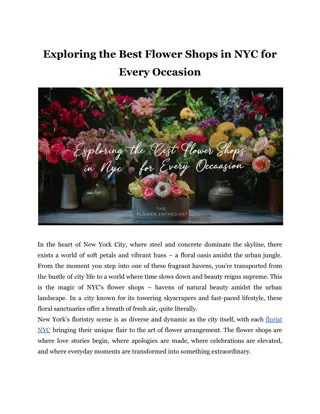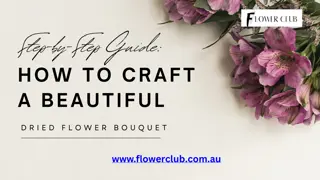Step-by-Step Guide to Drawing the Different Parts of a Flower
This step-by-step guide teaches you how to draw the different parts of a flower, including the roots, stem, leaves, sepal, carpel (pistil), petals, and stamen. Learn about the importance of each part in the flower's survival and reproduction. Follow the detailed instructions and accompanying images to create your own beautiful flower illustration.
Download Presentation

Please find below an Image/Link to download the presentation.
The content on the website is provided AS IS for your information and personal use only. It may not be sold, licensed, or shared on other websites without obtaining consent from the author. Download presentation by click this link. If you encounter any issues during the download, it is possible that the publisher has removed the file from their server.
E N D
Presentation Transcript
Step-by-STep Guide to Drawing the different parts of a Flower
1. First we are going to draw the roots of our plant and then the stem. Draw the stem however tall you like but make sure to leave room for the flower. How do the roots and stem help the plant survive? The roots and the stem help the plant stand up tall. They also allow water and food to move through the plant.
2. Next we are going to add some leaves onto the stem. Why do you think a plant needs leaves to survive? Leaves make food for the plant! They take in sun, carbon dioxide, and water and through a process called photosynthesis they make food (glucose/sugar) for themselves and oxygen for us. Here are some example leaves for your plant
3. Now we are going to draw the sepal at the top of the stem. Why do you think the sepal is important to the flower? The sepal may look like a leaf but its job is to support the petals when the flower is in bloom.
4. Next we are going to draw the carpel, also known as a pistil on the top of the sepal we just drew. This part includes the stigma, style, and ovary. Have you noticed this on a flower? How do you think this part helps the plant survive? This is the female part of the flower. The ovary is where the plant will either grow a fruit or seed. The style connects the ovary to the stigma. The stigma catches pollen from other plants.
Then we will add some petals on top of the sepal. Why does a flower need petals? 5. Below are some example petals. Petals use color and shape to attract animals to the flower for pollination. Pollination is important for plant reproduction and can also occur by wind and rain.
Last we will draw the stamen which connects to the ovary. The stamen includes the anther and the filament. Have you noticed this on a flower? How do you think this part helps a plant survive? 6. Draw the same number of stamens as petals. This is the male part of the flower. The anther produces pollen and the filament helps the anther stand up tall.
Not all flowers have all the parts we just drew. We just drew what is called a perfect flower. Perfect flowers contain both male and female parts. Imperfect flowers contain only female or only male parts. Try this challenge: Find perfect and imperfect flowers near your house.























